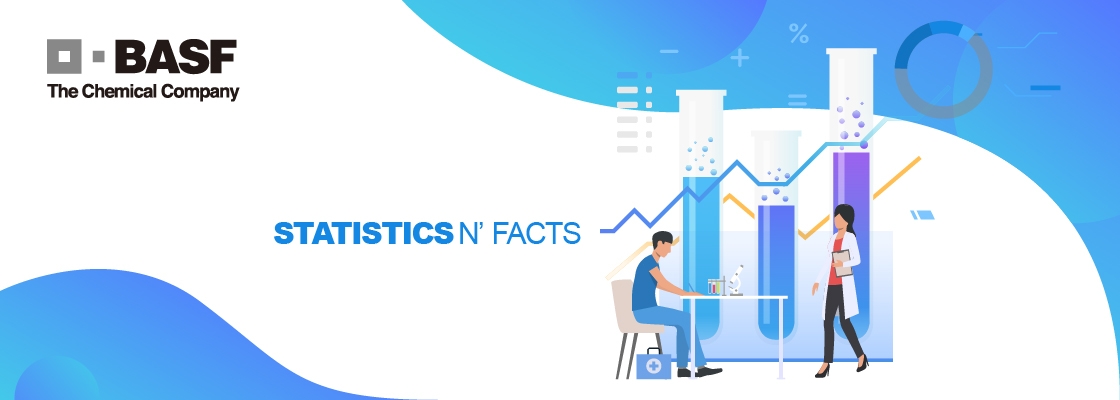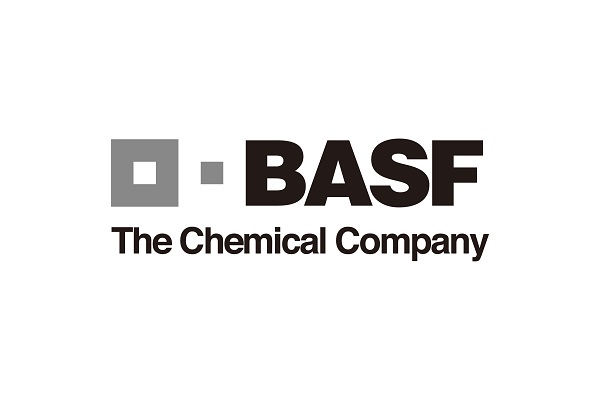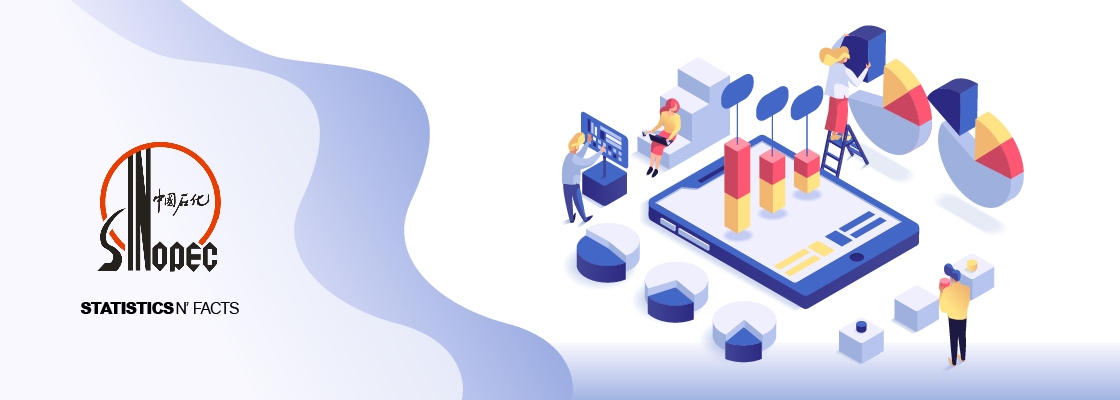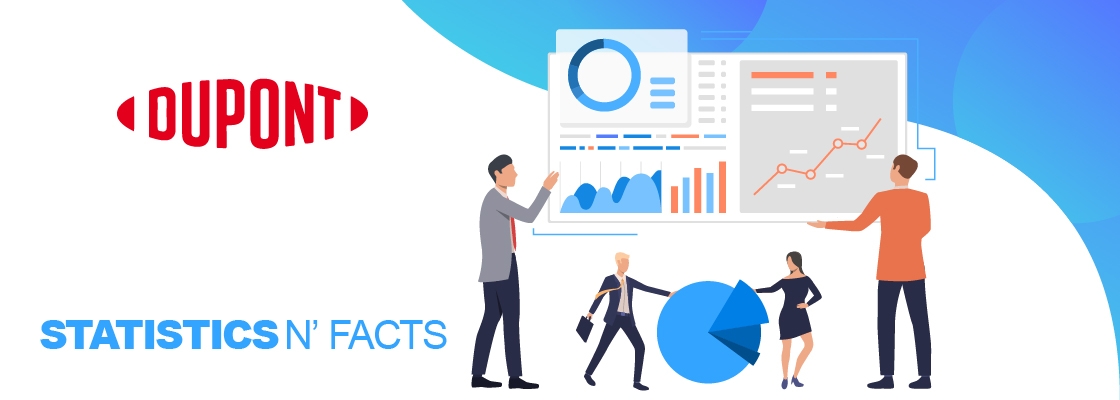BASF SE Statistics: BASF SE is a Europe-based chemical company that operates globally. BASF stands for Badische Anilin Und Soda Fabrik (German for Baden Aniline and Soda Factory). BASF was established in 1865 by Friedrich Engelhorn to produce dyes and other chemicals necessary for dye production, notably soda and acids. BASF holds one of the top three market positions in around 75% of the business areas in which it is active. Global competitors of BASF include Arkema, Clariant, Covestro, DowDuPont, DSM, Evonik, Formosa Plastics, Huntsman, Lanxess, SABIC, Sinopec, Solvay, Wanhua, and many hundreds of local and regional companies.
Financial Results in Perspective
In 2018, the company’s revenue was around US$ 70.8 billion, with the majority of revenue (US$ 24.2 Billion) coming from its functional materials & solutions segment. Its chemicals segment accounted for US$ 18.6 Billion, performance products segment for US$ 17.9 Billion, agricultural solutions segment for US$ 7.0 Billion, and the other segment US$ 3.1 Billion the same year.
Business Segments:
Till 2018, the company has been operating through five business segments namely: Chemicals, Performance Products, Functional Materials & Solutions, Agricultural Solutions, and Others.
Since January 1, 2019, BASF’s 12 divisions are grouped into six segments as listed below:
Chemicals: Petrochemicals and Intermediates
Materials: Performance Materials and Monomers
Industrial Solutions: Dispersions & Pigments and Performance Chemicals
Surface Technologies: Catalysts, Coatings, and Construction Chemicals
Nutrition & Care: Care Chemicals and Nutrition & Health
Agricultural Solutions: Agricultural Solutions
Through its chemicals segment, the company offers basic chemicals and intermediates and caters to the chemical and plastics industries.
Through its materials segment, the company offers performance materials, monomers, and other advanced materials, which include isocyanates and polyamides as well as inorganic basic products and specialties for plastics and plastic processing industries.
Through its industrial solutions segment, the company develops and markets ingredients and additives for industrial applications such as polymer dispersions, pigments, resins, electronic materials, antioxidants, admixtures, etc., and caters to automotive, plastics, electronics, and other industries.
Through its surface technologies segment, the company offers chemical solutions on and for surfaces. Its portfolio includes coatings, rust protection products, catalysts, and battery materials for applications in the automotive and chemical industries.
Through its Nutrition & care segment, the company focuses on expanding its position as a leading provider of nutrition and care ingredients for consumer products in the area of nutrition, home, and personal care.
Through its agricultural solutions segment, the company offers crop protection products and seeds. Its portfolio comprises fungicides, herbicides, insecticides, and biological crop protection products, as well as seeds and seed treatment products. It also offers farmers digital solutions combined with practical advice.
Acquisitions:
- In July 2018, BASF New Business GmbH (BNB) acquired Advanc3D Materials GmbH in Hamburg and Setup Performance SAS in Lyon in order to step forward in the field of 3D printing
- In April 2018, BASF acquired additional seeds and crop protection businesses and assets from Bayer AG
- In September 2017, BASF SE acquired the integrated polyamide business of Solvay S.A. in order to expand BASF’s engineering plastics portfolio and the company’s position as a solution provider for construction, transportation, industrial applications, and consumer industries
- In August 2017, BASF New Business acquired Netherlands-based filament producer Innofil3D in order to enhance its product portfolio
- In April 2017, the company acquired Mexico-based GRUPO THERMO TEK – a leading waterproofing systems supplier– to strengthen its geographic presence
- In February 2017, the company acquired Switzerland-based Rolic AG, which is a specialist in light management for advanced LCD/OLED displays. This acquisition was to expand the technology platform and product portfolio of the company’s display materials business.
Divestitures:
- In June 2017, BASF SE sold its electrolyte manufacturing site in Suzhou to Shenzhen Capchem
- In May 2017, the company divested its Micronal PCM business to Microtek Laboratories
- In April 2017, the company sold its bleaching clay and mineral adsorbents businesses to EP Minerals
Joint Ventures:
- In January 2019, in what makes it the largest investment by the company in India to date, BASF SE signed a Memorandum of Understanding (MoU) with Adani Group, to evaluate a major joint investment in the acrylics value chain. The designated site would be located at Mundra port in Gujarat, India, and a feasibility study is scheduled to be completed by 2019 end.
- In September 2018, BASF and LetterOne merged their oil and gas businesses in a joint venture, which will operate under the name Wintershall DEA. The transaction is expected to be completed in the first half of 2019.
- In May 2018, BASF SE and Solenis joined forces by combining paper and water chemicals businesses
- In March 2017, BASF leather chemicals business became part of Stahl Group, and BASF received a 16% minority stake in the Stahl Group
Strategies:
Goals:
- Financial Targets
- Grow sales volumes faster than global chemical production every year
- Increase EBITDA before special items by 3% to 5% per year
- Achieve a return on capital employed (ROCE) 1 considerably above the cost of capital percentage every year
- Increase the dividend per share every year based on a strong free cash flow
- Nonfinancial Targets
- Grow CO2-neutrally until 2030, and keep greenhouse gas emissions flat at the 2018 level
- Achieve US$ 24.8 Billion with Accelerator products by 2025
- Cover 90% of the relevant spend with sustainability evaluations by 2025 and have 80% of the company suppliers improve their sustainability performance upon re-evaluation
- Existing Nonfinancial Targets
- Reduce the worldwide lost-time injury rate per 200,000 working hours to ≤0.1 by 2025
- Reduce worldwide process safety incidents per 200,000 working hours to ≤0.1 by 2025
- Introduce sustainable water management at all production sites in water stress areas, and at all Verbund sites by 2030
- Increase the proportion of women in leadership positions with disciplinary responsibility to 22–24% by 2021
Investments:
- Investments make a decisive contribution toward achieving ambitious growth goals for the company. For the period 2019–2023, the company has planned capital expenditures (CAPEX) totaling €21.3 Billion (US$ 24.1 Billion) globally.
- Capex by Segment 2019–2023
- Capex by Region 2019–2023
Excellence program 2019 – 2021
- The company plans to digitalize 350 production facilities by 2022
- The estimated one-time costs of US$ 0.9 Billion will be incurred over the 3-year period
- Special charges in a mid-triple-digit million euro range are estimated to occur in 2019
- The company will contribute US$ 2.3 Billion annual EBITDA from 2021 onwards









